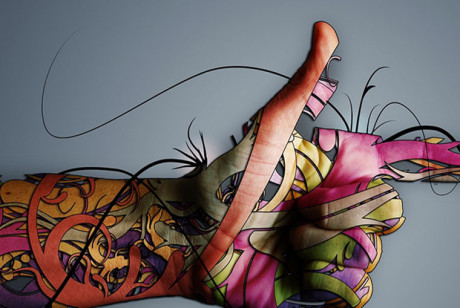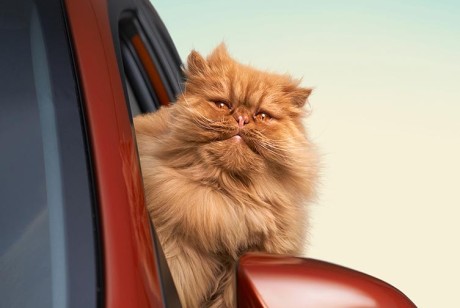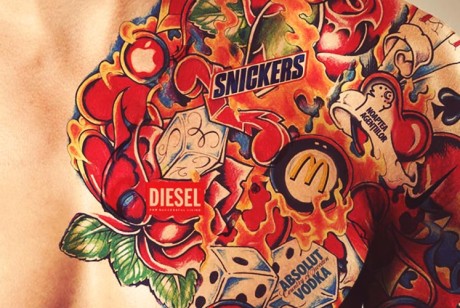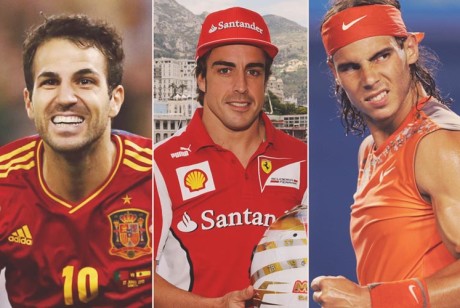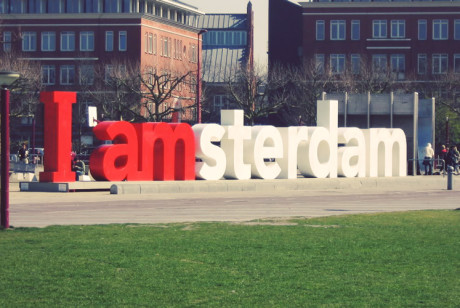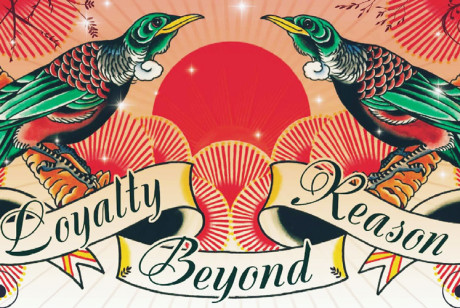Emotional Rescue at Adtech
Tuesday, 9 May 2000 - San Francisco, USA

Presentation Summary
An address to the Adtech Conference. If the internet is posed as a challenge to advertising, then emotion is the challenge for the Internet. Emotion is no longer ‘nice-to-have’ icing but the critical underpinning, the beating heart of any business whether it is operating online or offline.
Good morning. I’m Kevin Roberts, and I’m really happy. I’m taking it very personally that I’ve been invited here to represent the “traditional agency”. I’ve been set-up for target practice. Perfect.
We produced that ad starring the New Zealand All Blacks for the German sports apparel brand adidas, and entered it into a competition in Italy where it won the award for best commercial. The best part of the story though, is that we received the award in Milan from Pamela Anderson.
Successful ideas come from everywhere in the world today, no more so than from the edge. Asking the right question is the critical factor in sorting wheat from chaff.
I asked Tom Schnakenberg, the design head of Team New Zealand which has once again slaughtered all-comers by winning the America’s Cup, how they sorted through the hundreds of design ideas they generated. “There was only one question,” he said. “Does it make the boat go faster?”
I spent two days in England last month with John Chambers from Cisco, he’s constantly asking the same question about ideas for his business and his products – “does it make us go faster?”
Today I want to pick up the challenge of the Internet to the advertising business in the only way I know how: by getting up close and personal. I’ve been invited here to say what I think and I’ll do just that. But I also want to test out with you some new ideas and new thinking that’s happening right now in Saatchi & Saatchi.
First up, look around you. The advertising business is bursting with energy and life. Media spend across the board is exploding.
Producers are looking for new ways advertising can fund their cost of content. Branding is everywhere. Few surfaces are left untouched. Wild ideas are bubbling away and there’s a real sense of confidence and enthusiasm. Profits are real and expansionary. This is a great business to be in.
But let’s be very clear about this: advertising today is not a marketing expense, it’s a transactional expense, a selling expense. Putting advertising in the marketing budget is a mistake. It belongs right in the middle of the sales budget.
The role of advertising is to sell more stuff. It’s as simple as that. We’re about more transactions, richer transactions, faster transactions, longer-term transactions. More transactions with consumers individually or in groups, with other businesses, within businesses.
Advertising has about five seconds to work. People just won’t give you 60 seconds. No matter what the medium, advertising is an affair with instant – but not fatal – attraction.
And that’s why the Cluetrain Manifesto pisses me off. Networked conversations – good idea. More personalisation – makes sense. Getting personal – tell me about it. Straight talk – I like it.
Cluetrain has got a great title, snappy vocabulary and a list of do’s and don’t’s that appeal to lazy people.
But it’s so boring! They say markets are conversations, but they’re really talking about typing. Text, 12 point Times Roman. It may be text with attitude, but it’s still just text. What’s missing are the sensual dimensions of sound and light and colour. I guess someone gets off on smiley faces in emails, but I want more.
Me, I’m in your face with a great story and point of view about real products that real people buy everyday from real places. I believe in selling, in storytelling, in seduction.
Take a brand like Tide. It’s the number one choice of most Americans, and they make that choice for life. Now I simply don’t believe that Tide loyalists have any interest in accessing a list serv or any other virtual community to test that trust. Tide loyalists stick to their preference for decades. No MUDS required here.
Cluetrain for me stands for pervasive invisibility, a chilling objectivity and indeed, the disappearance of desire. It treats both producers and consumers who happily engage in that merry dance called “marketing” as being stupid and illiterate. Remember that individuals both need and want to buy stuff, they have favorites and they are very prepared to have relationships with products and services.
Cluetrain just doesn’t stop at the station for success in real live business. The New York Times got it right: “It is a phenomenon that offers middle-aged managers a second chance to sound a barbaric yamp and imagine a new significance to their lives.”
Don’t get me wrong, this is a time of real radical reinvention. Business models are flipping, consumer connections are being redefined, technology is roaring in all directions, media channels are exploding and morphing at the same time. It’s the most exciting time since … the sixties, when rock’n roll took over the world.
My company Saatchi & Saatchi is on a very different track to the Cluetrain. Our purpose is to create world-changing ideas that transform our clients’ businesses, brands and reputations.
It’s a mission that’s real, that works for our people, our clients and their customers. And we’ll use anything we can, whatever it takes, from zaplets to skywriting. We did a thirty six-hour television programme for one client at the millennium. We’re making a full length feature movie in Ibiza for our client Club 18-30. We’re not afraid of size, of doing it big, of engaging on a large scale.
We have 7000 people working in 152 offices in 92 countries on this mission. Our strategy is to burrow deep into the value chain. Our plan is to get into the guts of a business and help clients create entire new sectors, products, new ways of selling. No johnny-at-the-end-of the-production-line for us, but a seat right in the lab, in the garage, in the studio.
By the time it comes to talking to consumers, our ideas and creative are already embedded. We can bypass tired briefs and meaningless pitches juggling the same old concepts and outputs. Our clients don’t have to tell us what and how to create. We’re already there!
We stand for laser-like consumer insights, daring creativity, cool ideas, working with the best people, for creating the most powerful stories to spark lifetime love affairs between consumers and our clients’ brands. And to do it with a one team, one dream performing at their peak. Every day.
Toyota is the world’s most valuable vehicle producer, now exceeding the combined value of GM, Ford and DaimlerChrysler. One of the things we do for every Toyota vehicle we market around the world is to capture its essence to a single word.
In the case of the Toyota HiLux, it was “Powerful”. You won’t be surprised to hear the ad won a fistful of local and global awards, spawned dozens of front page stories as well as letters of outrage from mild-mannered citizens. In fact the impact of the idea has been so powerful that we tried to trademark the word “Bugger!”
Unfortunately we’ve had to concede it to Microsoft. Someone sent me an email that claimed ‘Bugger’ had been associated with Windows far longer and far more deeply than with Toyota’s utes. They suggested that every Windows user in the world uses the word at least once a day. “No other product,” the statement says, “has ever achieved that degree of market recognition and for Toyota to muscle in on it is clearly a breach of commercial etiquette and, ipso facto, copyright.”
Indeed, you can guarantee the word is rebounding around Redmond right at this moment.
Bugger is a big idea that cut through. Here in San Francisco the Attention Economy is operating at white hot intensity. I’m not just talking about every inch of outdoor space being saturated with advertising.
Autowraps.com is hard at work pasting ads onto private vehicles for up to $400 a week – depending on the brand!
The brain’s consistency is custard-like
Personally I’m concerned by that kind of over-exposure. It’s bullying, not communicating. I wasn’t surprised by the efforts of http://www.blowthedotoutyourass.com to subvert dotcom advertising here with their own stickers and poster. People aren’t dumb. If you’re simply making noise your brand will just be an irritant.
I now want to turn to the title of my speech: “Emotional Rescue” To quote Mick and Keith:
I’ll be your savior, steadfast and true
I’ll come to your emotional rescue
What goes around comes around. At last Emotion seems to be making the agenda of today’s business. Jerry Yang of Yahoo gets it: “People attach an emotion to our service. If we don’t have that emotion, we’re just like every other service.”
He goes on to put traditional benefit-selling in its proper place: “We don’t get people to come to the site by saying we have 10 million Web sites and our competitor has nine million. We’re not going to get them here by saying our response time is one nanosecond faster than our competitors. We’re going to get them based on an emotion.”
Emotion is no longer ‘nice-to-have’ for business – online or offline – but the critical underpinning, the beating heart. For something so crucial it is strange that business thinking about emotion is so out-of-date. And nowhere is it more out-of-date than in advertising on the Internet.
If the Internet is posed as a challenge to advertising, I’d have to say that the real challenge is how do we inject emotion into advertising on the Internet, which today is overwhelmed by rampant functionality and rational thinking.
How is it possible that the web is a seething maelstrom of every emotion you can think of – and some you probably shouldn’t – and yet the selling end, the part where advertising ought to count remains so cold, banal and benefit driven?
Coupons, banners ads, spam in its multitude of customised forms – we seem to have been there before. The most effective tool by far ever developed for selling stuff has been the television commercial. The 30 second TVC. It has steadily pumped economies worldwide for decades – and it is pumping still.
The strength of great TV commercials has always been their emotional pulse, the intimate connections they make with consumers. Getting emotion at that temperature into advertising on the Internet in a 1-to-1 narrowband environment – now that is a challenge. To meet that challenge we need a major rethink. And we need to start by updating our thinking about emotion.
What science can tell us about the brain and about emotion has grown exponentially over the last two decades. Let me crystalise my Seven Wonders of the Human Mind. I’m not a neuroscientist but my gut tells me that this stuff will drive a revolution in internet advertising over the next five years.
The First Wonder has to be the human brain itself – the most complex object in the known universe. There is no subject of scientific study to match it. MIT’s Steven Pinker reckons that the complexity of the Human Genome Project is a cinch compared with understanding the brain.
My Second Wonder is that while the brain may be complex, it’s grounded in a simple physical reality. The great biologist Edward O Wilson’s described it like this:
“The brain is a helmet-shaped mass of gray and white tissue about the size of a grapefruit, one to two quarts in volume, and on average weighing three pounds (Einstein’s weighed 2.75 pounds). Its surface is wrinkled like that of a cleaning sponge and its consistency is custard like, firm enough to keep from puddling on the floor of the brain case, soft enough to be scooped out with a spoon.”
How did you feel at the thought of your brain being scooped out with a spoon?
My Third Wonder is that human beings think with feeling and emotion. We just can’t help it. Emotion is the key to every decision we make, every thought we have. Human beings tend to take everything personally and respond with feeling.
All that stuff we’ve been told about “think before you act” and “think it through”. Rubbish. It doesn’t happen. Rational Man is a myth – and good riddance to him.
The brain has a built-in logic module
My Fourth Wonder is that most of our emotions seem to be out of control. Thank God! And I’m talking about all of us, not just teenagers.
Joseph Ledoux, one of the world’s leading researchers into the emotional brain, had this to say:
“Emotions are mostly processes at an unconscious level.”
This puts a lot of consumer research where it belongs: in the garbage. Consumers aren’t telling us what they “really feel” because they don’t know!
We’re pursuing new research styles based on heuristics or rules of thumb.
They are quick and focused on what really matters. They acknowledge that intuition, loyalty and emotion can’t be quantified, and then move on. And most importantly, they make us – the clients, the agencies, the marketers – front up with what we reckon we already know, rather than skulk behind meaningless facts from bewildered focus groups and generalising demographics.
My Fifth Wonder is the ability of humans to focus. Instead of experiencing the world as it is, I’m told that people experience only one trillionth of it.
Now I’ve no idea how they made that calculation, but you can see why our job is so damn difficult in this attention economy.
People focus on new events, on changes in their environment. They disregard the everyday and the routine. They pay attention till a need is satisfied and then they move on. We are all poor monitors of the routine.
Now this presents a major challenge for all of us in the attention industries. How do we attract attention and then hold it? My answer is that we can only do it with emotion. Mothers don’t treat their kids as routine and then forget about them. Why? Because of the emotional bonds tying them together. The evolving relationship. The nuanced responses on a daily basis. That’s the level we have to get down to.
My Sixth Wonder is the brain’s amazing cheat detector, as explained by Steven Pinker. It seems that humans have a built-in logic module, expert at evaluating exchanges – or transactions – to make sure there is no cheating going on. Calculating costs and benefits in real-life situations is what we are best at.
So why are we so great at this? It appears to stem from our deep past when you had to trade favours in order to survive. To avoid being taken advantage of you had to keep track of the favours you had taken and what you had given in return.
The theory is that this process of cheat detection is what most of our emotions are wrapped around. Liking maintains our partnerships; anger protects us if we are cheated; guilt torments us if it looks like our cheating will be exposed. Guilt is the gift that keeps on giving.
So based on all that, consider how a high volume transactional economy operating just with screen cues can overwhelm our poor cheat detector! No wonder trust matters. No wonder brands count. No wonder the trusted brand portals keep taking a bigger share of traffic.
My Seventh Wonder is our common evolutionary inheritance. Whether we live in New York or New Zealand, the research suggests that we are far more similar in how we think and feel than we are different.
This is one of the tenets of the rapidly growing discipline of evolutionary psychology. Controversial? Yes. Speculative? Of course. A big idea. Absolutely.
Maybe this will be one of the great insights of the new millennium in a rapidly globalising world. Instead of seeking nuances to drive us apart as we did in the nationalistic 20th century, the 21st century may bring us closer together.
I recently heard a presentation at a CEO Forum at Cambridge University last month that picked up some these insights from evolution. I know the science is outdated but I found the concept of the Triune Brain a really cool metaphor.
The Theory suggests that the human brain is composed of layers dating from different stages of our evolutionary past wrapped around each other.
- The outer layer of our brain package is the neocortex, the home of abstract thinking, creativity, reasoning and deliberation. This is where most of us like to think we live, but probably don’t.
- Inside that is the limbic system or mammalian brain in charge of the gentle emotions like those behind parenting, friendship and intimacy.
- And right at the core is my favorite, the Reptilian brain. The primal emotions driving survival through the Four Fs – feeding, fighting, fleeing and f…… sexual behaviour.
Sounds neat. Feels true. I don’t need it to precisely match current brain research to get something out of it. One of the ideas that has guided my life has always been to “trust your instincts” or, to mix metaphors, “Go with your gut.”
The idea of a hidden, unconscious, primal part of the brain driving much of what we do just turns me on. And if I can describe that “something” lurking in our heads as a reptile, so much the better.
So what does emotion reptilian-style look like? First up, it’s got to be behind the fierce territoriality and primal aggression of the Haka ad I showed you at the start of this presentation.
I can find it here too in the search for the right mating signal:
Although we weren’t thinking “reptilian” when we wrote those ads, our creative instincts moved to a deep and powerful place in the human mind.
It’s my gut instinct that insights like those in my Seven Wonders can open up new ways for us to connect with consumers’ emotions. And with more and more people living alone for longer, they are really going to need those emotional connections.
Now I’ve been in the brand business for thirty years, most of them as the client with Procter & Gamble, Gillette and Pepsico. Those thirty years have seen the creation of the great global mega brands. They’re what we measure ourselves against, what we have been committed to in this business to nurture and develop.
But now the very concept of brand itself has been commodified. Sometimes I swear it stands in for business itself.
I hear about the way the phone is answered is critical to the brand; that the look of an invoice impacts on the brand; that the flowers on the reception desk have to conform to the brand.
I must now reluctantly accept that the concept of brand has been hijacked by managerialism and had the juice sucked out of it in the process.
Brand has become bland, adding “E” to everything: standing for nothing, failing for everything. You can’t stretch something in all directions like that without it fraying.
But of course this presents a huge opportunity for ideas businesses like Saatchi & Saatchi. We can evolve great brands to the next level. The time is now. Brands know that standards are escalating, rules are changing, the future is snapping at their heels.
I don’t think every brand is going to be able to reinvent itself. Only the fittest survive. Some brands, well most brands, will keep doing what they’re doing and battle commodification for as long as they can.
But my evolved brands? I believe they will have to have strange new qualities to thrive in the environment of this millennium.
First, Mystery. Consumers don’t buy products for what they are, but for what they might be. We need to evolve mystery into an art form. We need to wrap brands in primal dreams and aspirations. Create stories that people find irresistible.
Put emotion first. Pull them with emotion, touch them with emotion, compel them with emotion. It may be reptilian-style emotion, it may appeal to nostalgia or community and the warmth of family. It may make them laugh, make them cry, make them jump.
Whatever it does it must go straight to the brain – the emotional brain.
Second my evolved brands must exude sensuality. People must want to stroke them, lick them, press up against them, squeeze them.
The current classics in the design world, of course, are the iMac and the new VW. The iMac is the most sensual product since the vibrator. The Beetle is the family member who just happens to live in the garage. Those luscious, delicious forms and colours. People want to pet them and take them home.
And have you noticed how people always use words about eating to describe them? Remember the iMac ads with the simple headline “Yum!”? That was an appeal to pure reptilian emotion.
In a world increasingly mediated by screens, I am convinced that the hunger for sensuality, for direct contact, will grow.
Think of my brain seeking to use its finely calibrated senses to create the world it experiences. It needs food to do that – food for thought, sure, but also food for touch, food for feel.
Wrapped in mystery and exuding sensuality, I believe that a truly evolved brand steps right out of the conventional frame and becomes something else entirely.
What we are seeing here is the great brands surging past the rest of the pack and evolving into Trustmarks.
Remember Trademarks stamping their officious, bureaucratic stamp on products and services? Procter & Gamble turned that world upside-down with the branding explosion of the last thirty years.
A Trustmark puts what is most important at its core – the trust of a consumer – and works out from there.
Putting “Trust” at the centre of brand evolution is not mere wordplay. Remember my Sixth Wonder of the Human Mind – the amazing cheat detector? Trust has turned out to be a fundamental of our very survival.
Who should I trust? Who shouldn’t I trust? These are the critical questions. These are the basic drivers of emotions. Love, friendship, respect, loyalty. Trustmarks are about relationships, not about information.
As media and environments change, consumers need new cues and triggers to guide them. Whatever they are, they must connect with the hearts, minds, guts and nerve endings of consumers.
So how do I see all this playing out in the e-world? That’s what you want me to talk about. Forget it. This “e-world” is still just the world – and I’d have to say that from a reptile’s point of view, it doesn’t have a lot to offer yet.
A standalone e-world is obsolete. At Saatchi & Saatchi we’ve taken back the “E” into real life and now it stands for Emotion. It’s also for Ease and for Engagement and for Entertainment. Put it down as well for Energy and Empathy. And throw in Edge.
I believe passionately that it is from the edges that the great, transforming ideas come – and it is great transforming ideas we always need.
Biological change usually first happens at the edges of a species’ range. Here the population is most sparse and the orthodoxies of the center weakest. If you want to evolve, that’s the best place to be.
That’s why I still live at the edge in New Zealand and only camp in London and New York. Come visit me on the edge at www.nzedge.com.
We should all be maximising the edges of our organisations. You should know who’s the youngest in your firm, the oldest, who’s from Iceland, from Bangalore and most important, who’s from New Zealand. Then go and draw on their edge. You’ll find that’s where your reptiles are lurking, and when you find them, give them everything they want and sign them up fast. A sun lamp, stock options, bugs. Whatever it takes. Maybe a camcorder will do.
Thank you.
